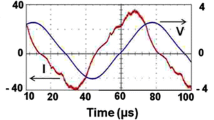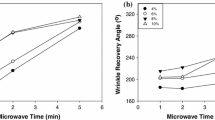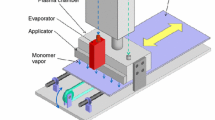Abstract
In recent years, cyclodextrin applications have been expanding to include textile finishing, providing new and unique functionalities to the fabric substrates. In this work the grafting of Per-(2,3,6-O-allyl)-β cyclodextrin by plasma and conventional thermofixation methods is described. The fabric substrate was cotton and activated by the surface modification of the fibers by the synthesis of iododeoxycellulose, cellulose peroxide, and a cellulose diazonium salt. Several plasma machines and conventional thermal techniques for fixation were studied. Iododeoxycellulose gave the best results by thermofixation and the in situ mode of the APJeT atmospheric plasma machine. Linoleic, ricinoleic, oleic acids were included in the grafted cyclodextrin fabrics as possible wound healing agents. The cyto-compatibility of the treated samples either included or un-included with fatty acids shows promising results.











Similar content being viewed by others
References
Grigoriu AM, Luca C, Grigoriu A (2008) Cyclodextrin applications in the textile industry. Cell Chem Tech 42:103–112
Akira H, Akihito H, Yoshinori T (2006) Cyclodextrin-based supramolecular polymer. Adv Polym Sci 201:1–43
Jozsef S (1998) Introduction and general overview of cyclodextrin chemistry. Chem Rev 98:1743–1753
Martin EM (2004) Cyclodextrins and their uses: a review. Process Biochem 39:1033–1046
Edward ML (2008) Plasma treatment for improved bonding: a review. J Adhes 30(1):199–218
Shishoo R (2007) Plasma technologies for textiles. Woodhead Publishing, Cambridge, pp 247–275
Vaideki K, Jayakumar S, Rajendran R (2009) Investigation on the enhancement of antimicrobial activity of neem leaf extract treated cotton fabric using air and oxygen DC plasma. Plasma Chem Plasma Process 29:515–534
Halil TS (2008) RF-argon plasma induced surface modification of paper. Surf Rev Lett 15(4):503–508
Marian JT, Cornelia V, Carmen MT, Maria CP (2008) Grafting of Spanish broom (Spartium Junceum) fibers with fatty acids under cold plasma conditions. Cellul Chem Technol 42(7–8):317–333
Boris V, Ariella S, Abraham JD (2008) The isolation of ricinoleic acid from castor oil by salt-solubility-based fractionation for biopharmaceutical application. J Am Chem Soc 85:169–184
Tyroxe LV, Donald JD, Clark MW (1973) Rot resistance and biocidal activity of halodeoxycellulose fabrics. Text Res J 43:715–718
Vigo TL, Daighly BJ, Welch CM (1972) Reaction of cellulose with chlorodimethylformiminium chloride and subsequent reaction with halide ions. Polym Lett 10:397–406
Wade RH, Reeves WA (1964) Preparation and some properties of the diazonium salt of cotton. Text Res J 34:836–841
Yupaporn K, Anawat A, Mongkol S (2008) Treatment of oxidized cellulose fabric with chitosan and its surface activity towards anionic reactive dyes. Cellulose 15:599–608
Liu XD, Nishi N, Tokura S, Sakairi A (2001) Chitosan coated cotton fiber: preparation and physical properties. Carbohydr Polym 44:233–238
Yoshitaka O, Tatsuo U, Hitoshi K (1979) Formation of peroxide on aldehyde cellulose and its ability to initiate graft copolymerization. J Appl Polym Sci 23:837–845
Hitoshi K, Yoshitaka O (1979) Decomposition of peroxide on carboxymethyl cellulose and its ability to initiate graft copolymerization. J Appl Polym Sci 23:241–247
Uno A, Olof S (1962) A colorimetric method for the determination of carbonyl groups in cellulose. Anal Chim Acta 27:434–440
Lahiani-Skiba M, Bouzbouz S (2010) Synthesis of per-substituted hydrophilic and hydrophobic β-Cyclodextrin derivatives. J Incl Phenom Macrocycl Chem. doi:10.1007/s10847-010-9749-9
Stavroula GS, Constantinos AG, Moschos GP (1999) Interaction of β-cyclodextrin with unsaturated and saturated straight chain fatty acid anions studied by phenolphthalein. J Incl Phenom Macrocycl Chem 34:85–96
Dominique D, Amelie B, Shan-Chen Y, Celine P, Monique S (2003) Cyclodextrin and emulsions. Int J Pharm 266:85–90
Wang C, Chen S (2004) Anchoring β-cyclodextrin to retain fragrances on cotton by means of heterobifunctional reactive dyes. Color Technol 120:14–19
Hirotsu T (2006) Plasma graft polymerization of glycidyl methacrylate and cyclodextrin immobilization. Thin Solid Films 506–507:173–175
Schofield WCE, McGettrick JD, Badyal JP (2006) A substrate-independent approach for cyclodextrin functionalized surfaces. J Phys Chem B 110:17161–17166
Myung HL, Kee JY, Sohk-Won K (2000) Grafting onto cotton fiber with acrylamidomethylated β-cyclodextrin and its application. J Appl Polym Sci 78:1986–1991
Hebeish A, El-Hilw ZH (2001) Chemical finishing of cotton using reactive cyclodextrin. Color Technol 117:104–111
Voncina A, Majcen LM (2005) Grafting of cotton with β-cyclodextrin via poly(carboxylic acid). J Appl Polym Sci 96:1323–1328
Kaewprasit C, Hequest E, Abidi N, Gourlot JP (1998) Application of methylene blue adsorption to cotton fiber specific surface area measurement: part I. Methodology. J Cotton Sci 2:164–173
Forster S, Mohr C, Viol W (2005) Investigations of an atmospheric pressure plasma jet by optical emission spectroscopy. Surf Coat Technol 200:827–830
Cherl WP, Seck JK, Sook JP, Jeong HK, Jung KK, Gu BP, Jeong OK, Yeong LH (2002) Inclusion complex of conjugated linoleic acid (CLA) with cyclodextrin. J Agric Food Chem 50:2977–2983
Retrieved from: http://www.txccc.org/home/content_images/HORTON_MTT_Cell_Assay_Protocol.PDF. 15 October 2010
Tseng HJ, Hsu S, Mien-Win W, Tien HH, Pei CT (2009) Nylon textiles grafted with chitosan by open air plasma and their antimicrobial effect. Fibers Polym 10(1):53–59
Garcia JL, Asadine A, Pachernik J, Lehocky M, Junkar I, Humpolicek P, Saha P, Valasek P (2010) Cell proliferation of HaCaT keratinocytes on collagen films modified by argon plasma treatment. Molecules 15:2845–2856
Author information
Authors and Affiliations
Corresponding author
Rights and permissions
About this article
Cite this article
Nada, A.A., Hauser, P. & Hudson, S.M. The Grafting of Per-(2,3,6-O-allyl)-β Cyclodextrin onto Derivatized Cotton Cellulose via Thermal and Atmospheric Plasma Techniques. Plasma Chem Plasma Process 31, 605–621 (2011). https://doi.org/10.1007/s11090-011-9300-9
Received:
Accepted:
Published:
Issue Date:
DOI: https://doi.org/10.1007/s11090-011-9300-9




